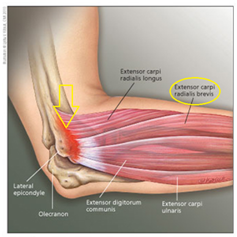Mill’s Test
Original Editor - Tyler Shultz, Matthias Verlinden
Top Contributors - Matthias Verlinden, Evan Thomas, Admin, Aminat Abolade, Rachael Lowe, Kim Jackson, Jennifer Chew, Tony Lowe, Magdalena Hytros, Mohit Chand, Tyler Shultz, Gayatri Jadav Upadhyay, Francky Petit, Bert Pluym, Kai A. Sigel, WikiSysop, Claire Knott and Wanda van Niekerk
Purpose[edit | edit source]
Diagnosing Lateral Epicondylitis in the elbow, also known as “Tennis Elbow”.
Clinical presentation[edit | edit source]
Presenting equally in men and women, 1% to 3% of the population will experience lateral epicondylitis in their lifetime, usually between ages 35 and 50.[1][2] Patients report pain at the lateral elbow that radiates down the forearm. In addition, patients often complain of weakened grip and difficulties lifting objects. On physical examination, patients typically have point tenderness medial and distal to the lateral epicondyle.[3][4]
| Condition | Patient age | Mechanism of injury | Symptoms aggrevated by | Observation | Tenderness with palpation |
|
Lateral epicondylitis |
35-55 | Gradual overuse | Activities involving wrist extention/grasping | Possible swelling (over lateral elbow) | Lateral elbow (over extensor carpi radialis brevis) |
Pathology[edit | edit source]
The histological aspects of the injury to the ECRB origin appears to be multifaceted, involving hypovascular zones, eccentric & concentric tendon stresses, and a microscopic degenerative response.[5]
In most cases the lesion involves the specialized junctional tissue (intercel adhesion molecules) at the origin of the common extensor muscle at the lateral humeral epicondyle, specifically the tendonous origin of Extensor carpi radialis brevis (ECRB) first time write in full. And in 35% of the cases the origo of m.extensor digitorum communis and ECRL will also be overstrained.[6] The lesion is characterized by microscopic tears, which may be superficial or deep and situated at the tendinous origin of ECRB into the periosteum of the lateral humeral epicondyle. Microavulsion fractures may be seen as well as lymphocyte infiltration, calcification, scar tissue, and fibrinoid degeneration may be evident in some cases; repair is by immature fibroblasts.[7][8]
Technique[edit | edit source]
1. Patient is seated.
2. The clinician palpates the patient’s lateral epicondyle with one hand, while pronating the patient’s forearm, fully flexing the wrist, the elbow extended.
3. A reproduction of pain in the area of the insertion at the lateral epicondyle indicates a positive test.[8]
Other Techniques to Diagnose Lateral Epicondylitis[edit | edit source]
Maudsley’s test = Resisted third digit extension
Cozen’s test = Resisted wrist extension with radial deviation and full pronation
Chair lift test = Lifting the back of a chair with a three finger pinch (thumb, index long fingers) and the elbow fully extended
Key Research[edit | edit source]
A study (By Tuomo Pienimäki et al. 2002) found that Pain thresholds at the lateral epicondyles are strongly associated with pain on palpation and a positive Mills test, providing evidence.[9]
Wadsworth found that a forceful Mills movement under general anesthesia produces an audible snap and provides good results, although no scientific reason is given. Hereby giving evidence for the effectiveness of the movement itself.
The Mills test is a very straightforward test who is described in most of the physical therapy manuals. Knowing that expert opinion is only level 5 evidence, consensus about diagnostic effectiveness by a range of experts, can be used to make weak recommendations where there is lack of higher quality evidence.
More research is required.
Resources[edit | edit source]
The Mills test is named after the clinical findings by G Percival Mills, F.R.C.S who published his findings in The British Medical Journal (Jan 7th 1928)[10] and updated this on July 31. 1937.[11]
References[edit | edit source]
- ↑ Nirschl RP, Ashman ES. Elbow tendinopathy: tennis elbow. Clin Sports Med 2003;22:813– 836.
- ↑ Allander E. Prevalence, incidence, and remission rates of some common rheumatic diseases or syndromes. Scand J Rheumatol 1974;3:145–153.
- ↑ Whaley AL, Baker CL. Lateral epicondylitis. Clin Sports Med 2004;23:677– 691
- ↑ Pomerance J. Radiographic analysis of lateral epicondylitis. J Shoulder Elbow Surg 2002;11:156 –157.
- ↑ FARO F , Wolf J. Lateral epicondylitis: Review and current concepts- journal of hand surgery Vol 32A NO.8 October 2007
- ↑ Pecina M. Bojanic. Overuse injuries of the musculoskeletal system. CRC press Boca Rotan, USA, 1993
- ↑ Wadsworth T, Tennis elbow: conservative, surgical, and manipulative treatment. British medical journal Volume 294 7 March 1987
- ↑ 8.0 8.1 Geoffroy P., et al. Diagnosing and treating lateral epicondylitis. Canadian Family Physician VOL 40: Jan 1994
- ↑ Tuomo Pienimäki, M.D Ph.D et al. Associations Between Pain, Grip Strength, and Manual Tests in the Treatment Evaluation of Chronic Tennis Elbow . The clinical journal of pain 18: 164-170 2002
- ↑ G. Percival Mills Treatment of tennis elbow. The British medical journal 12. Jan 7. 1928
- ↑ G. Percival Mills Treatment of tennis elbow. The British medical journal 212 July 31 1937







